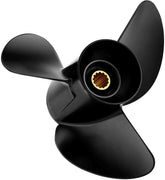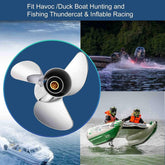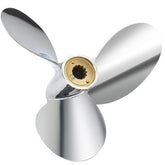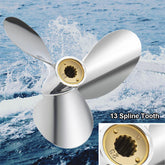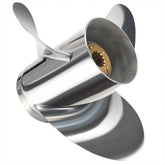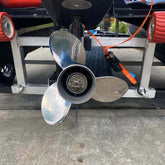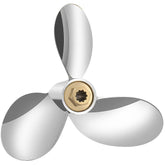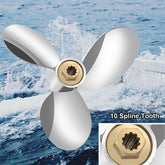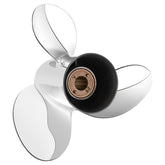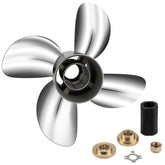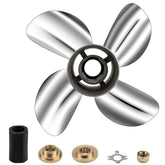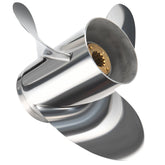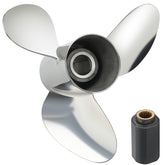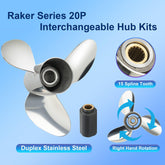3-Blade vs 4-Blade Propellers: Which Is Right for Your Outboard?
3-blade props generally give better top speed and fuel economy for light-to-moderate loads. 4-blade props give stronger hole shot, quicker plane, and better performance under load (heavy passengers, towing, pontoons). Choose 3-blades for speed-focused outboards, 4-blades for best everyday drivability and load-carrying. Stainless steel gives better performance than aluminum but costs more and transfers impact forces to the lower unit. If you’re tuning performance on a budget, VIF Marine’s factory-made stainless and aluminum outboard props deliver near-OEM specs at roughly 40–50% lower cost and are a great way to test options without breaking the bank.
Why this matters — how prop choice affects boat behavior
Whether you notice it or not, the propeller is the final mechanical link between engine power and water. A poorly chosen prop can leave your engine spinning out of its sweet spot, eat fuel, shorten range, reduce acceleration, and increase cavitation risk.
Diameter, pitch, blade area, and cup — what they do
-
Diameter: The circle described by blade tips. Larger diameter generally increases bite and low-end thrust, helpful for heavy boats.
-
Pitch: The theoretical distance the prop moves in one revolution through a solid — higher pitch = higher theoretical top speed but needs more power to reach target RPM. Example: a 15×19 prop has 15″ diameter and 19″ pitch.
-
Blade area / blade count: More blade area (or more blades) increases load capacity — useful for heavy loads, towing, rough water, or pontoon boats. But extra blades increase drag and can lower top speed.
-
Cupping / camber / rake: Cupping improves grip and reduces ventilation; rake affects bow lift and handling in rough water.
How props interact with hull, engine type, load, and trim
Prop choice is not isolated. A high-pitch prop on a heavily loaded boat may leave the engine lugging (low RPM) at WOT; a low-pitch prop on a light hull will spin the engine over redline and waste fuel. Hull form (planing vs displacement), transom height, trim tabs, and propeller shaft alignment all affect whether a 3-blade or 4-blade is best.
3-blade propellers — strengths, weaknesses, ideal users
Strengths
-
Higher theoretical top speed: Lower drag per rev than 4-blade of the same pitch.
-
Better fuel economy at cruise: Less wetted area and less drag.
-
Simpler, often cheaper: Widely available in many pitches and diameters.
-
Excellent for light loads & performance runs: Bass boats, solo runabouts, and light daycruisers often prefer 3-blades.
Weaknesses
-
Less low-end bite under load: Heavier loads can cause ventilation or slower acceleration.
-
Less forgiving when hauling or towing: May struggle to plane quickly with lots of gear or passengers.
Typical applications (bass boats, race, light load)
If your priority is top end and you usually run with just the driver plus minimal gear — a 3-blade stainless racing geometry or a high-quality aluminum 3-blade is often optimal.
Material notes: aluminum vs stainless on 3-blades
-
Aluminum 3-blade: Cheaper, lighter, bends on hit (sometimes protecting lower unit). Good for casual boating.
-
Stainless 3-blade: Thinner, stronger blades cut water better — higher acceleration and top speed; more expensive; bends less, so impact force transfers to lower unit.
4-blade propellers — strengths, weaknesses, ideal users
Strengths
-
Better hole shot and acceleration: Extra blade area grips water earlier.
-
Faster to plane with heavy load: Excellent for family boats, loaded pontoons, tritoons, and towing skiers.
-
Smoother cruise in chop and more predictable handling: Especially noticeable in rough water or when boat is overloaded.
-
Better thrust at lower RPM: Ideal when you have heavier gear, multiple passengers, or motors with limited torque curves.
Weaknesses
-
Slightly lower top speed (all else equal) due to greater drag.
-
Can increase fuel consumption slightly at WOT vs 3-blade of same pitch.
-
Often more expensive in stainless.
Typical applications (family boats, pontoons, heavy loads)
If you regularly run with family, gear, or tow tubes / skiers, or your hull is a pontoon/tritoon, a 4-blade will often make the boat more usable and safer — quicker to plane, more responsive at low speed, and better holding in chop.
When a 4-blade is NOT the right choice
If you’re chasing top speed in calm conditions with a minimum load, or if your engine’s torque curve is optimized for high RPM, a 4-blade may reduce your maximum achievable speed.
3-blade vs 4-blade — performance comparison table
| Attribute | 3-Blade | 4-Blade |
|---|---|---|
| Top speed | Higher | Slightly lower |
| Acceleration / hole shot | Lower | Higher |
| Planing ease (heavy load) | Worse | Better |
| Smoothness in chop | Good | Better |
| Fuel efficiency at cruise | Better | Slightly worse |
| Suitability for towing | Moderate | Excellent |
| Typical users | Racing, solo, light load | Family, pontoons, fishing boats |
| Common material options | Aluminum, Stainless | Aluminum, Stainless |
Other blade counts: 2-blade, 5-blade, and specialty props
-
2-blade — rare on modern outboards; may be used on older boats or slow displacement craft. Simpler, sometimes used for ice-breaking applications.
-
5-blade — used where maximum smoothness and thrust at low RPM are prioritized (some luxury boats and trolling applications). Big drop in top speed compared to 3-blade.
-
Cleaver & scimitar designs — advanced shapes (often 3-blade) that slice water for top speed on high-hp boats.
-
Multi-cup props (e.g., triple-cup) — designed to reduce slip and increase top speed in certain hulls.
Aluminum vs stainless — real-world tradeoffs (and VIF options)
Aluminum props
-
Pros: Lower cost, lighter weight, tends to “give” on impact (may save gearbox).
-
Cons: Thicker blades for strength → more drag at high RPM; more wear and erosion; less ideal for saltwater and high-hp applications.
Stainless steel props
-
Pros: Thinner, stronger blades → less drag and better top end; durable, minimal wear.
-
Cons: Higher cost; on impact, stiffness can transfer load to lower unit.
VIF options & positioning
VIF Marine manufactures both aluminum and stainless outboard props with CNC machining and automated QC. Their stainless props aim to match OEM geometries (Mercury/Yamaha/MerCruiser patterns) while being 40–50% cheaper than equivalent OEM stainless. They also offer aluminum lines for budget replacement and intermediate tuning.
How to choose the right prop for your outboard — a step-by-step workflow

Step 1 — Start with OEM baseline
Look at the engine decal or manual for factory recommended diameter × pitch (e.g., 14×17). That’s your starting point.
Step 2 — Define your typical load and use case
-
Solo, light load, racing → favor top speed/3-blade stainless.
-
Family, full load, towing → favor 4-blade or higher blade area.
Step 3 — Measure WOT RPM with current prop and GPS speed
-
If WOT RPM is below recommended redline → reduce pitch (smaller number) to raise RPM.
-
If WOT RPM is above recommended → increase pitch to reduce RPM (higher theoretical speed).
Step 4 — Use a prop selector & prop slip calculator
Tools: Mercury Prop Selector, Yamaha Prop Selector, Suzuki/Merc Prop calculators, and generic prop slip calculators. They help estimate expected RPM and slip.
Step 5 — Trial swap (+/–1 pitch) and re-test
Carry a ±1 pitch spare and test with real passengers and gear. Real world conditions beat charts.
Step 6 — Fine-tune blade area & cupping
If ventilation or cavitation occurs, consider cupping or a wider blade area (switch to 4-blade or add cup).
Use prop selector tools (Mercury, Yamaha, Suzuki) + prop calculators
-
Mercury Prop Selector: great for OEM matches and finding Flo-Torq equivalents.
-
Yamaha Prop Selector: same idea for Yamaha outboards; yields many 300+ fitment numbers.
-
Prop slip calculator: compute theoretical vs actual speed to identify inefficiencies.
-
Quicksilver / Mercury / OEM charts: list diameters, pitches, and suggested use.
Quick formula: Theoretical speed (mph) ≈ (Pitch × RPM) / 336
Then compute slip: slip% = (1 − actual speed / theoretical speed) × 100.
Measuring slip, WOT RPM, and GPS testing — practical walkthrough
-
Warm up engine and put boat in normal operating trim.
-
Run to WOT and record the tachometer RPM and GPS ground speed.
-
Compute theoretical speed using pitch and RPM formula.
-
Compute slip; typical target slip varies by hull, but 10–20% is common for planing hulls; too high (30%+) indicates mismatch.
Practical tuning tips (pitch changes, blade area, cupping)
-
If boat struggles to plane → lower pitch or increase blade area (4-blade).
-
If boat reaches plane but lacks top speed and RPM is below redline → lower pitch.
-
If engine hits redline before expected speed → increase pitch.
-
Cupping can add low-end bite without drastically changing pitch.

Prop damage, spun hubs, and repair options
Signs of a spun hub vs bent blades vs lower-unit damage
-
Spun hub: prop slips under load (engine revs but no thrust), progressive loss of thrust, excessive play in hub.
-
Bent blades: vibration at RPM, reduced top speed, visible blade distortion.
-
Lower-unit damage: grinding noises, oil leaks, severe vibration.
When to repair, when to replace, and how to protect your prop (guards, baskets)
-
Repair: minor blade straightening, hub replacement (if available). Many shops re-shape and re-cup props.
-
Replace: severe fracture, multiple bent blades, or spun hub beyond hub replacement.
-
Protection: propeller guards, propeller baskets, and reefing of depth can protect but often reduce efficiency. Rings/guards are designed to protect swimmers and reduce marine life entanglement — they add drag and are a tradeoff between safety and performance.
VIF Marine: a cost-effective route to testing 3 vs 4 blade setups
Manufacturing & QC highlights (factory / CNC / ISO)
VIF uses automated casting, robotic CNC machining, and multi-point QC checks including dynamic balancing, CMM pitch verification, and salt-spray corrosion testing. That means VIF props can closely match OEM pitch/profile tolerances at significantly lower price.
Product coverage (HP ranges, typical pitches, blade counts)
VIF produces stainless and aluminum props across common outboard HP bands:
-
Small outboards: ~4–15 HP (small diameters, low pitch).
-
Mid-range outboards: ~25–150 HP (most common bass boats, family runabouts).
-
High HP outboards: 150–300+ HP (large center-consoles and offshore rigs).
They offer 3-blade and 4-blade options, with cleaver or cupped geometries in select stainless models. If you want the exact SKU table (MEGARA, YANTA, SEMA, POLASTORM series, with pitch/diameter/blade counts), tell me and I’ll paste your product sheet rows into the article.
Warranty, US warehousing, and OEM/custom builds
VIF backs props with a 180-day warranty on manufacturing defects and operates U.S. warehouses for quick shipping and returns — a strong selling point for North American buyers who want factory prices without long lead times. They also support OEM and custom prop manufacturing for boat builders.
Quick reference — prop calculators, pitch charts, and useful links
-
Mercury Prop Selector — OEM match chart (use to find factory pitch/diameter)
-
Yamaha Prop Selector — choose by model & RPM band
-
Prop slip / pitch calculators — compute theoretical vs actual speed
-
How Boat Propellers Are Manufactured — internal guide for manufacturing details (useful if you evaluate VIF or any factory-direct brand): https://vifmarine.com/how-boat-propellers-are-manufactured/
Image suggestions and SEO/UX placements
-
Header hero: “3-Blade vs 4-Blade Propellers” — action shot of prop in water.
-
Diagram: pitch × diameter × blade area explanation (alt text: “prop pitch and diameter explained”).
-
Comparison photos: closeups of a 3-blade aluminum, 3-blade stainless, 4-blade stainless.
-
VIF factory: CNC machining and warehouse photos.
-
Quick charts: WOT RPM testing spreadsheet screenshot and slip calculation example.
Frequently Asked Questions (FAQ)
Below are practical forum/video-style questions integrated with concise answers. These are SEO-friendly and cover many of your supplied keywords.
What is the port side of a boat?
Port is the left side of a boat when you face the bow (front). The port side light is red; starboard side light is green.
What side is starboard?
Starboard is the right side when facing forward toward the bow.
How do I remember port vs starboard?
Memory trick: Port and Left both have four letters — port = left. Or think red port wine for the red light on the left side.
Which side of a boat is starboard and port?
Facing the bow: left = port, right = starboard. From the stern facing forward the terms are unchanged (always referenced to bow direction).
What determines if a speed is safe for your boat?
Safe speed depends on visibility, traffic density, water and weather conditions, hull design, load, local speed limits, and operator skill. In restricted or “no wake” zones always follow posted speed rules.
What is a propeller shaft?
A propeller shaft (prop shaft) transmits torque from gearbox to the propeller hub. Proper course, alignment, and a functional shear pin or hub are essential for safe operation.
What is the difference between a propeller and an impeller?
-
Propeller: external blade(s) rotating in water to produce thrust (boats).
-
Impeller: part of a waterjet or pump that moves water through an internal channel (jet skis / PWC). Impellers are usually enclosed and have different hydrodynamic principles.
2-stroke vs 4-stroke outboard — which is better?
-
2-stroke: traditionally lighter, higher power-to-weight ratio; modern direct-injection 2-strokes are cleaner.
-
4-stroke: smoother, quieter, more fuel-efficient, better emissions. Most modern outboards are 4-stroke for consumer use.
How to use a prop calculator or pitch chart?
Find your current pitch and WOT RPM, measure GPS speed, compute theoretical speed = (pitch × RPM) / 336, then slip% = (1 − actual/theoretical) × 100. Use vendor prop selectors for baseline pitch recommendations.
What is a spun prop or spun hub?
A spun hub occurs when the rubber hub inside the prop slips on the splined shaft — symptoms include loss of thrust, slipping under load, and inability to plane. The fix is hub replacement or new prop.
Can I put a Mercury prop on a Yamaha?
Often physical fit is possible if spline and hub type match, but differences in pitch ratings, hub systems, and thrust washer selection mean results vary. Always confirm fit and re-test RPM.
Do I need a propeller guard?
Propeller guards reduce the risk of cuts and entanglement but add drag and reduce efficiency. For swim areas, rental PWCs, or guides working with swimmers, they make sense. For high performance, guards are rarely used.
3-blade vs 4-blade prop — which should I try first?
If unsure, try the OEM-recommended 3-blade baseline. If you need better acceleration under load, move to a 4-blade or to a 3-blade with more blade area/cup. For pontoons and tritoons start with a 4-blade baseline.
How much difference does stainless give vs aluminum?
Stainless typically yields 3–6% higher top speed and better acceleration because blades can be thinner and more efficient; exact difference depends on hull and engine.
What’s the best prop for wakeboarding or tubing?
Wake riders often want bigger, lower RPM torque — choose a 4-blade or cupped 3-blade with slightly lower pitch to build a bigger, more consistent wake.
How to tell if I should change pitch up or down?
Check WOT RPM with the boat in typical load. If RPM < recommended range → reduce pitch. If RPM > recommended range → increase pitch.
What do propeller rings/guards/baskets do?
They protect swimmers, prevent lines or weeds from catching the prop, and reduce intake of marine debris — with performance tradeoffs (more drag).
How do I winterize my outboard or jet ski impeller?
Drain fuel, fog the engine, flush with fresh water, stabilize fuel, remove battery, and store off the trailer. For jet skis, follow OEM-specific winterization steps.
Final recommendations — choosing your next prop
-
Start with the OEM recommended prop and test WOT RPM with your usual load.
-
If you need better acceleration/planing, try a 4-blade or drop pitch; for more speed try a thinner stainless 3-blade or higher pitch.
-
Use GPS and tachometer data to make objective choices (don’t guess).
-
If testing multiple props, consider cost: VIF Marine stainless props let you experiment with near-OEM geometry at substantially lower cost, backed by U.S. warehouse support and a 180-day warranty.
-
Protect your investment: carry a spare hub kit, keep an eye on blades for damage, and store your prop properly in off-season.


